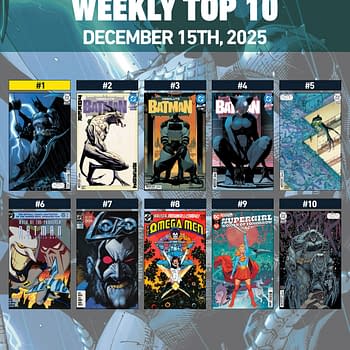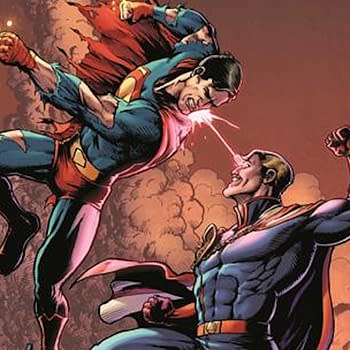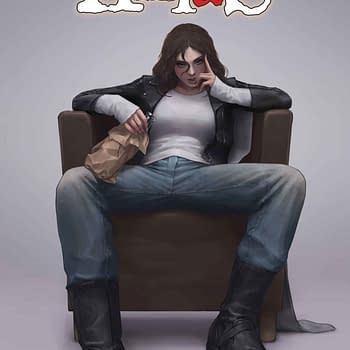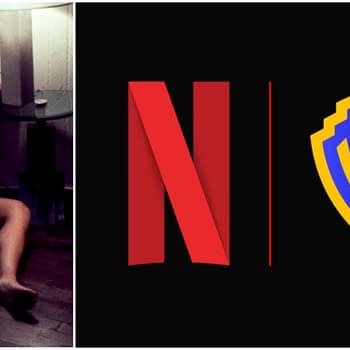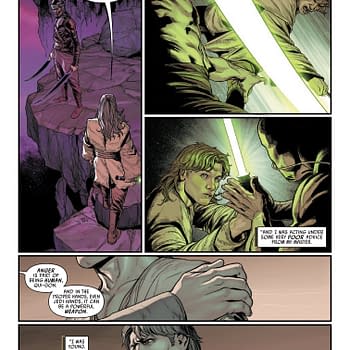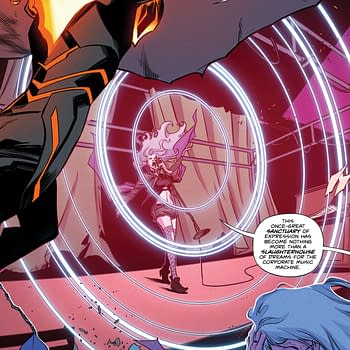Posted in: Comics, Recent Updates | Tagged: Comics, games, grand theft auto, scarface
Look! It Moves! by Adi Tantimedh #133: Saints Of Comedy Mayhem
[youtube]http://www.youtube.com/watch?v=csTf2Z7xlQ0[/youtube]
WARNING: SPOILERS ABOUT SAINTS ROW: THE THIRD AND THE GLORIOUSLY SILLY BOLLOCKS IT GLEEFULLY TROTS OUT.
For the past week, the pop culture comedy that's had me hooked was not a movie or TV show but a game: SAINTS ROW: THE THIRD.

SAINTS ROW: THE THIRD mitigates any accusations of amorality through crazy satire – it's really too ridiculous
to be taken seriously. Its gangster plot is really an excuse to indulge in the catalogue of crazy stories that define the current pop culture landscape, not just in movies and TV but games. The previous games had more straight plots about a gangster's utterly amoral rise to the top like a kind of sociopath simulation game. The point of the last game was to play someone unwaveringly evil, stealing cars, getting into insurance scams, getting in bed with corrupt politicians, killing rivals, all to acquire as much money, power and a reputation as possible. The second game had a strange inconsistency of tone, with its straight if still cartoonish gangsta narrative set in a corrupt, amoral world sitting next to increasingly absurd satirical side missions like moonlighting as a bodyguard protecting a visiting celebrity and throwing any overzealous fans, stalkers and haters into helicopter blades or driving a sewage truck to spray local buildings with shit in order to drive property prices down so a corporation can buy them up cheap. Only the over-the-top violence was consistent but the nastiness of the main plot and its attempts at pathos didn't sit well with the jokey satire of the side missions.
While the GRAND THEFT AUTO series evolved toward
s more serious and somber morality tales about crime and America, the SAINTS ROW series moved in the other direction to establish its own identity as a crazy do-what-thou-wilt sandbox game. What THE THIRD does is throw all seriousness to the wind and focus on the crazy fun of all pop culture. Unlike the last two games, the tone here is outright comedy. The nameless protagonist and his/her cohorts are subtly written now as more likable, like smart geeks at play. They're not real gangsters, they're us playing gangsters in a pop culture playground of slapstick violence and cartoon carnage.
It's still a corrupt, amoral universe but a more overtly cartoonish one, and the main characters are more likable now (despite being murderous psychopaths) than they were in the last games, often reacting to the ridiculousness of it all. The core theme of wanting to be a top dog, to be somebody over the anonymous faceless public that are there to be victims and easy marks, but the morality tale of being an evil gangster is softened by the fact that the enemies are far worse and the main characters are now the comedy underdogs against a larger body of baddies that want to wipe them out. They're up against Mexican Wrestler gangsters and computer geek gangsters, and the military declares martial law and invades the city with high-tech weaponry that the Saints get to steal and use in their own arsenal. In this messed-up cartoony nihilistic game universe, being a murderous psychopath becomes the only logical choice to make, but you're a NICE murderous psychopath who's loyal to your mates. It's all about the FUN mayhem.
SAINTS ROW: THE THIRD might be the most self-aware piece of pop culture of this generation. It calls into question why we like escapist genre fiction and games, shows up how absurd and silly it all is, all that pretending, by being so over-the-top it's practically in orbit, but that we come back to them again and again because they're FUN. It appeals to the kid in us, the kid that likes to make things up without censorship or logic, and the kid that likes to break things.
Now the ridiculous things you can and want to do in the game make sense with the story rather than work against it. If you want your gang boss character to be not the usual good-looking bad-ass, you can create a well-spoken sexy middle-class girl who knows how to shoot guns and kill people. Or a fat, unshaven Cockney transvestite in a cocktail dress, luscious blo
nde wig and raccoon eye make-up. Or a skinny old black woman pensioner in a housecoat and bunny slippers who speaks like a professional dominatrix. Or a nudist in a funny animal mask (with the naughty bits pixilated). None of that makes any less sense in a world of Luchadore gangsters, a street chase and shootout involving rickshaws pulled by gimps wearing bondage gear, a hulking Russian strongman held prisoner by a crime syndicate so they can clone him to create endless mindless brute thugs even though he's not only perfectly articulate but an intellectual, and Burt Reynolds as the mayor of the most comically corrupt gang-infested city in America.
Trying to describe this game makes me sound like an 8 year-old on crystal meth. The ethos of the game's writers is the same as that of Monty Python's: that of smart people deliberately telling the most stupid jokes they can possibly think of, as meticulously as possible. Stories are the translation of ideas into active drama and emotional experiences, and what intrigues me about games is how they turn the experience of dramatised ideas into one you actively have to participate in rather than passively watch them unfold before you like a movie, TV show or story you read. SAINTS ROW: THE THIRD is amazingly sophisticated in the way it makes you question the nature of genre fiction itself – gangster stories, cyberpunk thrillers, science fiction, military thrillers, slapstick comedy, farce – as you play one ridiculous, farcical chapter to the next. Nothing proceeds without your active participation, the story does not move until you've raided the rival gang's headquarters, jumped out of their private jet at 30,000 feet and landed safely on the ground, defeated the hacker-geek gangster in cyberspace in a spoof of TRON where your avatar switches between being a toilet with a gun and a blow-up sex doll. You have a choice of what weapons to use, including utterly absurd ones like the gun that shoots a cute Japanese squid that takes over someone's mind and makes them attack their friends until they explode or a gun that fires fish guts at enemies to lure a JAWS-type shark to through the ground, even when you're nowhere near the sea, to eat them.
The other thing about a game like this and SKYRIM is the way it lets you play through the fights the way you want or need, resulting in an experience uniquely your own. At one point, I (or rather my player avatar) was required to hijack a military vertical takeoff jet fighter to help my crew escape their attack when they declare martial law in the city and war against The Saints. I had to attack the soldiers' makeshift command centre while being attacked by other jets, which shot lasers and microwave cannons at me. My jet get so damaged I knew it would blow up soon, so I jumped out and parachuted to the street where more soldiers, tanks and the other jets proceeded to chase and attack me. I ran for a while, little ol' me being chased by two jets, three tank, a dozen soldiers and three military transport vehicles, all firing lasers and microwave cannons at me as I desperately looked for a vehicle to jump into and escape, since there were no jets on hand to replace the one I jettisoned, which did explode in mid-air seconds after I jumped out. It occurred to me to run up to one of the sexy tanks chasing me and take it over. It worked. I used it to blow every vehicle chasing me to buggery before destroying the command post, and my crew radioed to tell me to find Oleg, my Russian hulk homie, in the park and help him fight off the soldiers. I drove my now-damaged tank over to the park where Oleg was singlehandedly holding off five tanks. I jumped out of my burning tank and hijacked one of his attackers and blew the rest of them up. I then realised the one I was driving needed to be destroyed in order for the game to continue, and in the way the level was designed, I was supposed to be flying a jet and using its cannons to blew up these tanks, but again, there were no jets around to fly. Grenades and a rocket launcher failed to dent it until I had an idea. I drove the tank into the park's pond and let it sink to the bottom. That seemed mark the tank as destroyed and the battle officially ended. I was glad the designers gave you those options to play. This was more fun than watching any CGI'd-up-the-arse action scene in a typical Hollywood movie.
Oh, and later, zombies attacked. I fought them off with a giant purple dildo. Then I blew up 300 of them with a giant 16-bit tank that I brought back from my battle in cyberspace. How many people can claim to do that in WALKING DEAD?
The biggest issue for me here isn't whether games can be Art, but that Games can be COMEDY!
Blowing shit up for the lulz at lookitmoves@gmail.com
Follow the official LOOK! IT MOVES! twitter feed at http://twitter.com/lookitmoves for thoughts and snark on media and pop culture, stuff for future columns and stuff I may never spend a whole column writing about.
Look! It Moves! © Adisakdi Tantimedh












